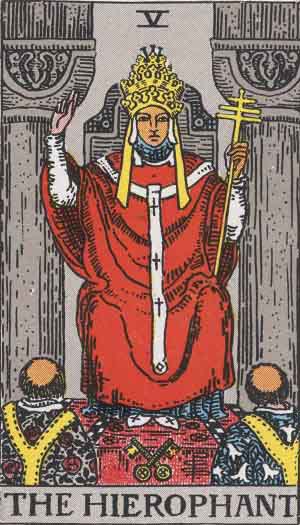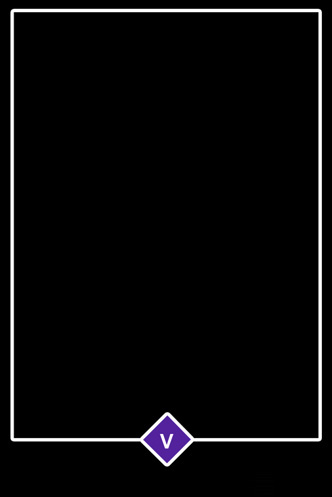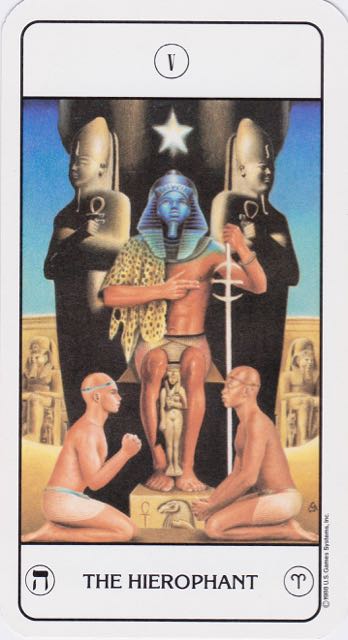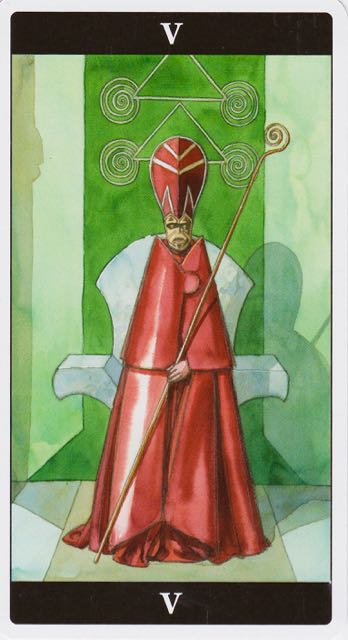
5 The Hierophant
He wears the triple crown and is seated between two pillars, but they are not those of the Temple which is guarded by the High Priestess. In his left hand he holds a sceptre terminating in the triple cross, and with his right hand he gives the well-known ecclesiastical sign which is called that of esotericism, distinguishing between the manifest and concealed part of doctrine. It is noticeable in this connexion that the High Priestess makes no sign. At his feet are the crossed keys, and two priestly ministers in albs kneel before him. He has been usually called the Pope, which is a particular application of the more general office that he symbolizes. He is the ruling power of external religion, as the High Priestess is the prevailing genius of the esoteric, withdrawn power. The proper meanings of this card have suffered woeful admixture from nearly all hands. Grand Orient says truly that the Hierophant is the power of the keys, exoteric orthodox doctrine, and the outer side of the life which leads to the doctrine; but he is certainly not the prince of occult doctrine, as another commentator has suggested.
He is rather the summa totius theologiæ, when it has passed into the utmost rigidity of expression; but he symbolizes also all things that are righteous and sacred on the manifest side. As such, he is the channel of grace belonging to the world of institution as distinct from that of Nature, and he is the leader of salvation for the human race at large. He is the order and the head of the recognized hierarchy, which is the reflection of another and greater hierarchic order; but it may so happen that the pontiff forgets the significance of this his symbolic state and acts as if he contained within his proper measures all that his sign signifies or his symbol seeks to shew forth. He is not, as it has been thought, philosophy—except on the theological side; he is not inspiration; and he is not religion, although he is a mode of its expression.
A. E. Waite, Pictorial Key to the Tarot (1911)
A priest or a teacher, a "maker of bridges" who represents a wounded part of ourselves and therefore he is open to the worlds pain and longing. Suffering in ordinary life make us question and open the way to a greater understanding of the higher laws of life. He is seeking for answers of a philosophical kind and a link between spiritual and material values, an advisor, analyst, psychotherapist. Here we have responsibility, faith, idealism, knowledge and an individual vision of the spirit, which guides us as we leave childhood behind and venture out into life's challenges.

5 - No-Thingness
Being "in the gap" can be disorienting and even scary. Nothing to hold on to, no sense of direction, not even a hint of what choices and possibilities might lie ahead. But it was just this state of pure potential that existed before the universe was created. All you can do now is to relax into this no-thingness...fall into this silence between the words...watch this gap between the outgoing and incoming breath. And treasure each empty moment of the experience. Something sacred is about to be born.

Tarot of the Ages - Mario Garizio ©1988 U.S. Games Systems, Inc.
Spirit is the final leg of the triad that has been previously seen in the Empress and Emperor; the archetype of the spiritual world is the Hierophant. This is the card of beliefs, both religious and otherwise, though it does tend to focus on the religious and spiritual aspects because the Hierophant himself is often depicted as a holy man. Indeed, in some decks this card is known as the Pope or High Priest. But in actuality, a Hierophant is a person who holds 'forbidden' or 'secret' knowledge. While this could easily apply to the clergy, it has far greater scope than this. In a way it could be said that (with apologies to Crowley) every man and every woman is a Hierophant.
The Hierophant can even stand for groups of more than one person, and in the majority of cases he is better represented by an institution than by a single person. This is because his is the power of the group and the society, who change the world to fit their beliefs. The same theme of control and change that first appeared with the Magician continues here in its fifth iteration; now there is still a well-defined leader, but the people do not follow him because they are ordered to. They follow because they are part of the group. The main philosophies of the Hierophant are that there's no "I" in "team", and that the good of the many outweighs the good of the one.
Such a philosophy may seem unnecessarily restrictive but, as the Emperor has taught us, restriction leads to order. The Hierophant is charged with the maintenance and propagation of tradition and conventional beliefs, and anyone who goes against these beliefs is shunned. Balance and conformity are the goals of the Hierophant, and neither positive nor negative is emphasized - only tradition matters. In extreme cases, this can indeed have very negative effects (as Galileo found out) but in most cases having some tradition to follow is beneficial. The traditions and ceremonies of the church, which are particularly strong in this card, are a prime example of this.
On a more personal level, the Hierophant is also a teacher or a mentor. One major role of a spiritual leader is to initiate others into the community and teach them the ways of the group. Obviously one who holds the secrets and is entrusted with the traditions of the group is a prime candidate to teach them to others, and the Hierophant plays this role well. Though his approach to teaching is one that centers on conformity and shuns individual expression for the moment, this can be helpful. Only once the student has mastered the ways of the group can he or she properly decide whether to remain or leave.
When the Hierophant appears it will often be in the form of a teacher or a mentor, who instructs you in the ways of his particular belief in the hopes that you will join him. Such teachers do not have to be of a spiritual or mystical background; an employer training a new employee in the operation of a business is as much a Hierophant as any religious teacher. If your current situation seems to require more experience then you can call upon, be open to the presence of a teacher or mentor in your life. But do not make the grave mistake of openly seeking such a teacher - as the old proverb says, when the student is ready, the teacher will appear.
The Hierophant can also represent group activities and beliefs, and in either case, support of the establishment and respect for the rules are emphasized. So if you are planning something revolutionary, the repeated appearance of the Hierophant is a good sign to forget such action and go with the flow for the time being. The traditional way of doing things must work most of the time, or else it wouldn't have been around long enough to become tradition! However, when an idea is proven wrong it is certainly time for a change. The true Hierophant is one who has a deep respect for his beliefs, but who will not blindly follow them to his own ruin.

Tarot of the Dream Enchantress ©2009 Lo Scarabeo